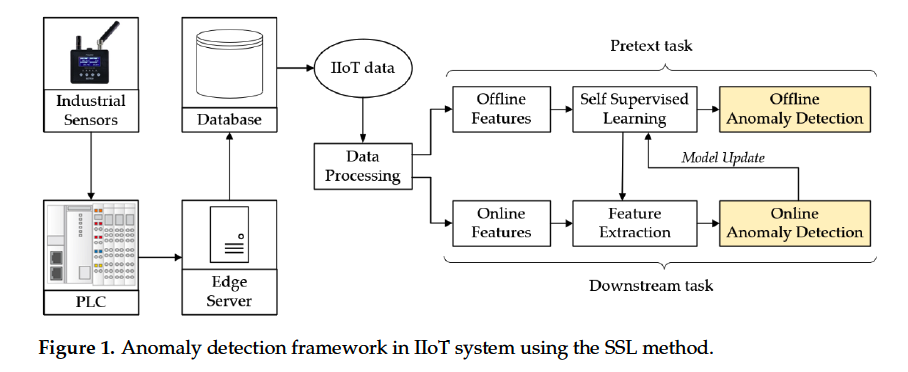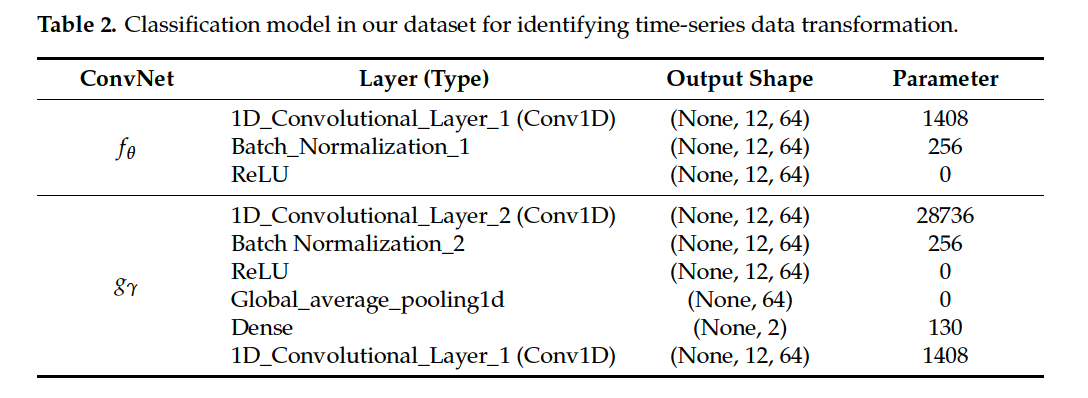SSL for TS Anomaly Detection in Industrial Internet of Things
Contents
- Abstract
- Introduction
- 2 types of abnormality
- TS AD
- AD methods
- Proposal
- Related Works
- Traditional AD
- SSL for AD
- Data Preprocessing
- Data Collection & Preprocessing
- Sliding Sample
- Methodology
- SSL
- AD
0. Abstract
proposes an AD methodm using a SSL framework in TS darta
TS data augmentation for generating pseudo-label
Classifier : 1d-CNN
- will measure the degree of abnormality
1. Introduction
(1) 2 types of abnormality
- (1) point anomaly : single data point
- (2) collective anomaly : continuous sequence of data points considered anomalous as a whole
(2) TS anomaly detection
-
aims to isolate anomalous subsequences of varying lengths
-
simple technique : Thresholding
- detects data points that are outside their range of normal
( Unfortunately, many anomalies do not cross any boundaries; for example, contextual anomalies : may have “normal” values but are unusual at the time they occur )
\(\rightarrow\) difficult to detect
(3) Anomaly detection methods
a) various statistical methods
ex) Statistical Process Control
- detected as an anomaly if it fails to pass statistical hypothesis testing
- huge amount of human knowledge is still necessary to set prior assumptions for the models
b) unsupervised ML approach
ex) segmenting a TS into subsequences of a certain length
& applying clustering algorithms
ex) deep anomaly detection (DAD)
learn hierarchical discriminative features from historical TS
either predicts or reconstructs a TS
( high prediction or reconstruction errors = anomalies )
-
cons)
-
inflexible enough in traditional approaches
- edge devices lack dynamic and automatically updated detection models for various contexts
- difficult to obtain a large amount of anomalous data
-
(4) Proposal
novel solution for automatic TS AD on edge device
introduces an efficient realtime framework with 2 phases
- (1) offline training
- (2) online inference
a) offline training
-
selects historical data from the DB for model training
-
DL is provided for automatically detecting the anomalies, using SSL
-
only the normal data is learned in the training process
\(\rightarrow\) explore the features of the supposedly “normal” TS
b) online inference
- employed in real time
- model is updated if the number of abnormal samples is greater than a specified threshold
2. Related Works
(1) Traditional AD
[training] only normal data is provided
[testing] model predicts whether a test sample is normal
various algorithms based on DAD : divided into 3 categories
-
(1) Supervised DAD
- uses the labels of normal and abnormal data
- ex) [2] employed LR + RF for AD and their categorization
- ex) [3] based on LSTM with statistical properties
-
(2) Semi-supervised DAD
- ex) [4] employed DBN (Deep Belief Nets)
- ex) [12] proposed 2 semi-supervised models, based on the generative feature of VAE
- still requires that the relationship between labeled & unlabeled data distn holds during data collection
-
(3) Unsupervised DAD
-
trained using the normal data
\(\rightarrow\) when data falls outside some boundary condition, considered anomaly
-
VAE, GANs are trained to generate normal data
-
either (1) predict or (2) reconstruct TS
-
ex) [20] : One-class GAN (OCGAN) to improve robustness using a denoising AE
-
ex) [15] : LSTM–Gauss–NBayes
- stacked LSTM : forecast the tendency of the TS
- NBayes : detect anomalies based on the prediction result
-
(2) SSL for AD
SSL process : separated into 2 successive tasks
- (1) pretext task training
- (2) downstream task training
Inspired by the SSL approach for AD…
\(\rightarrow\) propse new solution! based on augmentation of TS
( first to apply principles of the SSL to TS for AD )
- transform TS to different sequences, using the rotation and jittering method before training a classifier ( = trained based on normal data )
- inconsistency when training with abnormal data could be used as

3. Data Preprocessing
(1) Data Collection & Preprocessing
Historical TS is extracted from the DB for data preprocessing
Data preprocessing :
- raw data \(\mathbf{X}=\left(x^1, x^2, x^3, \ldots, x^S\right)\),
- where \(x^i \in \mathbb{R}^{M \times 1}\) indicates \(\mathrm{M}\) feature at sample \(i\)
- \(S\) : total sample of the raw data collection
Process
- step 1) Convert timestamps into the same interval
- inconsistency of the timestamps may occur
- Step 2) Clean data
- data collection may obtain some missing value due to the different types and impacts
- alignment of data timestamps also causes missing values
- ex) k-nearest neighbor imputation
- Step 3) Integrate multiple-sensor feature into single MTS
- Step 4) Scale MTS
- for sustainable learning process
- use StandardScaler : \(x_{m(\text { scaler })}^i=\frac{x_m^i-\mu(x)}{\sigma(x)}\)
- \(x_{m \text { (scaler) }}^i\) : scaled value for the \(m\) th feature
- \(x_m^i\), the \(m\) th feature from time
(2) Sliding Sample
appy the sliding window to generate TS data containing the time dependence
- \[\mathbf{X}_{T S}=\left\{x_{s e q}^{(n)}\right\}_{n=1}^N\]
Each data has \(T\) steps
- \(x_{\text {seq }}^{(n)}=\left(x_1^{(n)}, x_2^{(n)}, x_3^{(n)}, \ldots, x_T^{(n)}\right)\).
- \(x^t \in \mathbb{R}^{N \times T}\) : \(\mathrm{N}\) dim of measurements at time step \(t\)
Goal of TS-AD :
- find a set of anomalous time sequences \(\mathbf{A}_{\mathrm{seq}}=\left(a_{\mathrm{seq}}^1, a_{\mathrm{seq}}^2, a_{\mathrm{seq}}^3, \ldots, a_{\mathrm{seq}}^k\right)\),
- \(a_{\text {seq }}^i\) : continuous sequence of data points in time that show anomalous values within the segment

- size of the sequence window (timestep) : \(T = 300\)
4. Methodology
divided into 2 phases
-
(1) offline training
-
SSL pretext task training
-
contains historical TS data
-
step 1) TS is first fed into preprocessing scheme
-
step 2) deploy DA based on jittering./rotation for pseudo-label
-
step 3) feature of each TS is fed into classifier
- determine which scaling transformation should be employed
-
trained on normal TS data
\(\rightarrow\) maximize the loss, when identifying an anomlay sequence
-
-
(2) online monitoring
- use what we learned in the offline phase, for downstream tasks
(1) SSL
Goal : learn useful representations of the input data w.o annotation
employ a new architecture for the TS
- pseudo label was generated based on the jittering and rotation
- identification model for predicting the scaled transformation

Jittering :
- presupposes that noisy TS are common
- \(\zeta_A\left(x_{\text {seq }}^{(n)}\right)=x_1^{(n)}+\varepsilon_1, x_2^{(n)}+\varepsilon_2, \ldots, x_T^{(n)}+\varepsilon_T,\).
- \(\varepsilon \sim \mathbb{N}\left(0, \sigma^2\right)\).
- \(\sigma\) : pre-determined hyperparameter
- \(\varepsilon \sim \mathbb{N}\left(0, \sigma^2\right)\).
- Adding noise to the inputs is a well-known method for increasing the generalization
Rotation :
- can change the class associated with the original sample
- \(\zeta_B\left(x_{\text {seq }}^{(n)}\right)=R\left(x_1^{(n)}\right), R\left(x_2^{(n)}\right), \ldots, R\left(x_T^{(n)}\right)\).
- \(R\left(x_t^{(n)}\right)=-x_t^{(n)}\).
- \(R\) : element-wise rotation matrix that flips the sign of the original TS
Summary :
-
added with noise and flipped by \(\zeta_A\) and \(\zeta_B\).
-
TS matrix : \(\mathbf{X}_{T S}\)
-
each sequence of data \(x_{\text {seq }}\) : transformed into new sequences…
- \(\mathbf{z}_{\text {seq }}^A\) : by jittering equation \(\zeta_A\left(x_{s e q}\right)\)
- \(\mathbf{z}_{\text {seq }}^B\) : by rotation equation \(\zeta_B\left(x_{s e q}\right)\)
-
new sequences were finally gathered
\(\rightarrow\) form \(\mathbf{Z}_{s e q}^A\) and \(\mathbf{Z}_{\mathrm{seq}}^B\)
Final output :
- consisted of two different values
- each representing the probability of jittering data & rotation data

(2) AD
Once \(g_\gamma\) was trained ( based on the self-labeled )
- (Normal) expected to be correctly identified by classifier
- (Abnormal) likely mislead the classifier into predicting the probability of jittering and rotated data
Discrepancy between the
- (1) predicted output by the classifier output
- (2) ground truth of input data
\(\rightarrow\) indicate the degree of abnormality
New data \(x_{\text {seq }}^{(i)}\), DA technique \(\zeta\) was applied to generate a new dataset \(\zeta\left(\mathbf{X}_{T S}\right)\) with pseudo label
Degree of the anomality :
- \(\mathcal{L}\left(f_\theta\left(\zeta\left(\mathbf{X}_{T S}\right)\right), y\right)=-\frac{1}{N} \sum_{i=1}^N\left[y_i \log \left(\hat{y}_i\right)+\left(1-\hat{y}_i\right) \log \left(1-\hat{y}_i\right)\right]\).
- set the threshold for AD, based on the max values of the CE loss function in the training dataset
